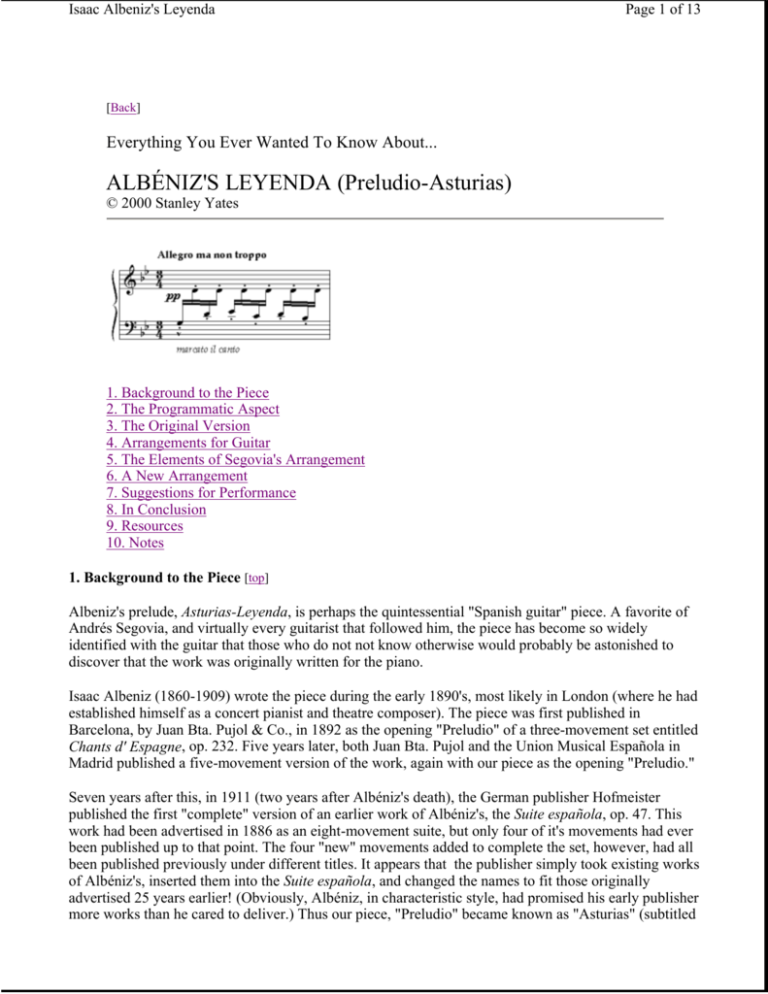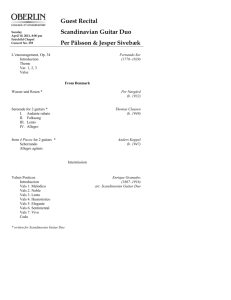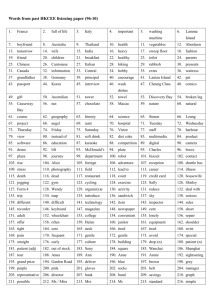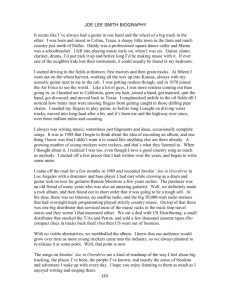ALBÉNIZ'S LEYENDA (Preludio-Asturias)
advertisement

Isaac Albeniz's Leyenda Page 1 of 13 [Back] Everything You Ever Wanted To Know About... ALBÉNIZ'S LEYENDA (Preludio-Asturias) © 2000 Stanley Yates 1. Background to the Piece 2. The Programmatic Aspect 3. The Original Version 4. Arrangements for Guitar 5. The Elements of Segovia's Arrangement 6. A New Arrangement 7. Suggestions for Performance 8. In Conclusion 9. Resources 10. Notes 1. Background to the Piece [top] Albeniz's prelude, Asturias-Leyenda, is perhaps the quintessential "Spanish guitar" piece. A favorite of Andrés Segovia, and virtually every guitarist that followed him, the piece has become so widely identified with the guitar that those who do not not know otherwise would probably be astonished to discover that the work was originally written for the piano. Isaac Albeniz (1860-1909) wrote the piece during the early 1890's, most likely in London (where he had established himself as a concert pianist and theatre composer). The piece was first published in Barcelona, by Juan Bta. Pujol & Co., in 1892 as the opening "Preludio" of a three-movement set entitled Chants d' Espagne, op. 232. Five years later, both Juan Bta. Pujol and the Union Musical Española in Madrid published a five-movement version of the work, again with our piece as the opening "Preludio." Seven years after this, in 1911 (two years after Albéniz's death), the German publisher Hofmeister published the first "complete" version of an earlier work of Albéniz's, the Suite española, op. 47. This work had been advertised in 1886 as an eight-movement suite, but only four of it's movements had ever been published up to that point. The four "new" movements added to complete the set, however, had all been published previously under different titles. It appears that the publisher simply took existing works of Albéniz's, inserted them into the Suite española, and changed the names to fit those originally advertised 25 years earlier! (Obviously, Albéniz, in characteristic style, had promised his early publisher more works than he cared to deliver.) Thus our piece, "Preludio" became known as "Asturias" (subtitled Isaac Albeniz's Leyenda Page 2 of 13 "Leyenda"), the advertised fifth movement of Albéniz's Suite española. Does all this really matter? I believe it does, since the title of a piece tells us something of its intended character. The titles of the movements advertised for Albéniz's earlier Suite española draw upon a wide range of Spanish provinces: Aragon, Andalucia, Castile, Catalonia, as well as the Northern mining region, Asturias. The Chants d' Espagne, the collection in which our piece was originally published, however, is inspired entirely by the Andalucia region - the home of flamenco, and of the Moorish invasion. We need only compare the image of the Asturian bagpipe (the defining folk instrument of that region) with the Andalucian guitar to realize that Albéniz's inspiration for the Preludio was not Asturias. As we shall see below, there are several aspects of the Andalucian culture that held special meaning for Albéniz. By what name should we refer to the piece then? Clearly, the misleading "Asturias" is out of the question. Albéniz's original title "Preludio," while it does not misrepresent the character of the piece, says little about its identity. The publisher's subtitle "Leyenda," on the other hand, is a quite evocative and identifiable title. Although probably not one supplied by Albéniz himself, with clarity in mind, "Leyenda" (Legend) seems a good choice. 2. The Programmatic Aspect [top] Albéniz's Leyenda, a most evocative piece of music, has inspired numerous dramatic stories, ranging from biblical thunderstorms to devasting earthquakes, which are usually found as adornments to the backs of old album covers. However, Albéniz's nostalgia for his homeland was expressed in much more romantic, and much more inventive, terms than these. Imagining himself of Moorish ancestry, most of Albéniz's own comments concerning the programmatic aspect of his music derive from images of the Alhambra - the elaborate Moorish palace-fortress that overlooks the Andalucian city of Granada. Of this place (which he visited on several occasions), Albéniz imagined evening serenades and juergas (allnight gypsy flamenco parties), accompanied on the one hand by the strumming of guitars and on the other by the "lazy dragging of the fingers across the strings" of the guzla, an ancient arabic instrument (a single example of which Albéniz surely never saw, let alone actually heard), Speaking in 1886 of his serenata, Granada, Albéniz wrote: I live and write a Serenata...sad to the point of despair, among the aroma of the flowers, the shade of the cypresses, and the snow of the Sierra. I will not compose the intoxication of a juerga. I seek now the tradition...the guzla, the lazy dragging of the fingers over the strings. And above all, a heartbreaking lament out of tune...I want the Arabic Granada, that which is art, which is all that seems to me beauty and emotion... [note 1] Albéniz's powers of musical description and romantic invention extended well beyond the realities of his life and his actual experiences (even producing a very colourful autobiographical account of a young life that, in reality, was quite uneventful). [note 2] Albéniz could hardly have visited for himself the "tower" that inspired the title of one of his best-known piano works, Torre bermeja. If he had, he would hardly have been inspired to capture the experience in music. An amusing description of the "Torre bermeja" is provided by American author James Michener, who visited the "Vermillion Tower" on the strength of having heard Albéniz's piano work. Fully expecting to find a "splendid Moorish monument" he instead found "a pair of square, dumpy things...a squat tower built of ugly brick in the worst possible proportions, as far removed in spirit from the music of Albéniz as one could imagine." [note 3] No doubt, Albéniz too had been captivated by the evocative words, "Torre bermeja," which was enough to inspire him to the composition of a piece of music that described something deriving only from his powerful romantic imagination. Isaac Albeniz's Leyenda Page 3 of 13 So what was the inspiration behind Albéniz's preludio, Leyenda? Living outside Spain (most of his pieces in "Spanish" style were written in London and Paris), Albéniz felt a nostalgia for his homeland which evoked images of flamenco, and of the ancient, Moorish quality of Andalucia - even though Albéniz was a Catalan, he identified his "Spanishness" with Andalucia and even imagined that he was of Moorish ancestry (apparently an entirely unfounded notion). Albéniz's music also responds to the religious collision between the Moors and Christians in Spain, inspired by the juxtaposed architecture of those surviving, awe-inspiring mosques of Granada, Sevilla and Cordoba, which later became catholic cathedrals. All of these elements are to be found in our piece. The opening section of the work could hardly be more evocative of the flamenco guitar, with its "open-string" pedal point and "rasgueado" chords (figure 2): The slow central section is more sophisticated. The opening phrases evoke the cante jondo, the improvised solo song of that persecuted Indian-Jewish-Gypsy cultural amalgam that produced what we today call flamenco (figure 3): This eventually gives way to a more rhythmic, dance-like section with more active "guitar accompaniment" (figure 4): Aesthetically, the final coda is the most sophisticated part of the composition. As with his Cordoba (a piece in the same cycle, inspired by another city famous for it's mosque-cathedral), Albéniz introduces a series of pure diatonic choral-style harmonies, evoking the music of the Christian church, and reflecting the imposition of that religion on the ancient Moorish architecture (figure 5a): Isaac Albeniz's Leyenda Page 4 of 13 Albéniz does not view this as a conquest, however, and following a tentative reference to the main flamenco theme of the piece there appears a harmonically remarkable passage: an impressionistic blur of superimposed tonic ("Christian") and phyrigian augmented-sixth ("Muslim") harmonies. The work ends on bare octaves (no clear reconciliation or triumph here) (figure 5b): 3. The Original Version [top] Before discussing guitar arrangements of the piece, we should take a brief look at the first version for piano (which differs, in a couple of interesting ways, from later published versions). Although no manuscript version of the piece is known to exist, I have been able to locate a copy of the first edition (which actually contains the signature and ex-libris stamp of no less a figure than Ricardo Viñes, the virtuoso pianist and personal friend of Albéniz): As already mentioned, this first edition of the three-movement version of the Chants d' Espagne, (Preludio-Orientale-Sous le Palmier) was published in Barcelona in 1892 by one of Albéniz's main publishers of the time, Juan Bta. Pujol & Co., with the plate number P. 22 C. These movements appear in identical form in the five-movement versions of the Chants d' Espagne published by Juan Bta. Pujol and Union Musical Española in Madrid in 1897. Indeed, the engraving was made from the same plates. Isaac Albeniz's Leyenda Page 5 of 13 Turning to the version of the piece that appeared as "Asturias-leyenda" after Albéniz's death, in the first edition of the "complete" Suite española, published in Leipzig in 1911 by Friedrich Hofmeister, we find a slightly different version of the piece. Interestingly, Union Musical Española, who also published a "complete" version of the Suite española in 1918, edited by Juan Salvat, re-engraved the piece but clearly based it on the earlier version rather than the "revised" Hofmeister version. All subsequent editions of the piece to the present day, however, appear to be derived from the slightly altered Hofmeister edition. We can therefore establish that two basic versions of the piece exist: 1. the original version published as "Preludio" in the early versions of the Chants d' Espagne (1892 and 1897); the version that appeared as "Asturias-Leyenda" in the 1918 Union Musical Española edition of the Suite española 2. the revised version published as "Asturias-Leyenda" by Hofmeister in 1911 in the first "complete" edition of the Suite española (upon which subsequent editions of the piece appear to have been based, for example the widely distributed version edited by Isador Phillip, first published in 1952 by International Music) The essential differences between the two early versions of the piece are few, but significant. The original tempo marking "Allegro ma non troppo" in the later version became "Allegro" with an attached metronome marking of quarter-note = 132. The unmarked central section of the original version is marked "Più Lento" in the later versions with a metronome marking of quarter = 80. There are also differences of dynamic and expression markings. The dynamic range of the main section of the piece in the earlier version pp - fff is moderated in the later version p - ff. The central section has less detail of expression markings in the later version, therefore appearing less expressive, especially in the matter of rhythmic flexibility. Perhaps the most interesting difference, though subtle, concerns the addition of an accidental to several phrases in the melodic cante jondo section of the piece (figure 6): The later editions added a natural sign to the grace-note c-natural, removing the evocative augmentedsecond interval. Albéniz used this "forbidden" melodic interval to evoke the Moorish quality of the cante jondo in several other pieces, including Granada, "a lament out of tune" (see the quotation above). Isaac Albeniz's Leyenda Page 6 of 13 That c-sharp is indeed the pitch intended by Albéniz is verified by the fact that in all other instances of this grace-note figure in the piece, Albéniz used the customary shorthand sign (see figure 3, above). Only in the special case of those figures that use the augmented-second did he take the trouble to write out the notes in full. 4. Arrangements for Guitar [top] Several items of the Albéniz's piano repertory were arranged for guitar during the composer's lifetime. The first guitarist to do so was probably Francisco Tárrega (1852-1909), a fellow Catalan and an almost exact contemporary of Albéniz. Tárrega's most illustrious student Miguel Llobet also made guitar arrangements of Albéniz's piano music, apparently with the blessing of the composer, since Llobet performed Albéniz's Granada in a concert arranged by Albéniz himself in Barcelona in 1906. [note 4] However, the first successful guitar arrangement of the preludio Leyenda no doubt belongs to Andrés Segovia, though he wasn't the first guitarist to perform or arrange the piece. That distinction should probably go to the very prolific arranger Severino García Fortea. In his autobiography of the years 18931920, Segovia mentions that he was "transcribing Leyenda by Albéniz, which hereto had been played from the transcription made by that hack[!], Don Severino Garcia." [note 5] Although I have not been able to determine when Segovia first began to include the piece in his recital programs, we do know that he programmed the piece for a recital in Graz, Austria in October, 1924. [note 6] Although the program is lost, it is quite possible that Segovia also programmed the piece for his milestone debut in Paris, earlier that year. Segovia did not record his arrangement until much later, in 1953 (it appears on An Andres Segovia Recital on the Brunswick label, AXTL 1005), and he did not publish it until three years after that, in1956 (with Ricordi American in Buenos Aires). From this point on, a steady stream of guitar arrangements of Leyenda began to appear on the market, the majority tacitly taking Segovia's edition as their primary source. 5. The Elements of Segovia's Arrangement [top] Albéniz's piano original cannot be played on the guitar unedited; the original key of g-minor is unsuitable, many octave doublings and chord voicings cannot be reproduced, the original registration of the piece extends beyond the tessitura of the guitar, and the dynamic range (a long, continuous crescendo from pp to fff, for example) cannot be realized literally. In addressing these issues, Segovia introduced a number of distinguishing features into his arrangement of the piece: He added guitaristic triplet figuration in the outer Allegro sections (figure 7): Isaac Albeniz's Leyenda Page 7 of 13 (He also departed from the constant staccato articulation of the original by adding sustained bass notes, as can be seen above). He also introduced triplet figuration in a passage at the end of the slow central section that refers to the texture of the opening Allegro section (inadvertently disguising the relationship between the two sections?) (figure 8): And he again used tripet figuration at the end of the piece, where the original presents an impressionistic blur of superimposed tonic and augmented-sixth harmonies (the original is again set in the rhythm and texture of the opening Allegro section) (figure 9): The Allegro sections end with a "guitaristic" flourish which, while perfectly reasonable on the piano, cannot be reproduced literally on the guitar. Segovia substituted pizzicato eighth-notes and a concluding chord (figure 10): Isaac Albeniz's Leyenda Page 8 of 13 At one point in the Allegro sections it becomes impossible to retain both the upper and lower notes of an evocative Phrygian augmented-sixth chord. Segovia substituted the following chord, which preserves the correct upper tone, but alters the bass-note (figure 11): 6. A New Arrangement [top] In preparing my edition, Isaac Albéniz: 26 Pieces Arranged for the Guitar for my series with Mel Bay Publications, I was faced with the inevitable: I would have to make an entirely new arrangment of Leyenda. Following the criteria that I had established for the rest of the edition, working from the very first edition of the piece and intent on resisting the weight of tradition, this resulted in quite some differences between my version and the one previously established by Segovia. Here are some of the issues I addressed in the arrangement. As already mentioned, the outer Allegro sections of this piece evoke the flamenco guitar, specifically the technique of playing a lower-voice melody with the thumb underneath a repeated upper open-string pedal, punctuated (later in the section) with emphatic "rasgueado" chords. To my ear, the interest in such passages lies in the momentary "collision" and crossing of the parts. I therefore chose a fingering that "plays" with the timbral differences between the repeated-note open-string pedal and the fretted melody beneath (rather than placing this melody on the fourth and fifth strings, as do traditional guitar arrangements of the piece) (figure 12): Isaac Albeniz's Leyenda Page 9 of 13 I also maintained the staccato articulation of lower voice and rasgueado chords throughout the Allegro sections. Such chords as the following are damped by the left-hand immediately after strumming (figure 13): Albéniz's original keeps to sixteenth-note rhythm thoughout the Allegro section. The effect is one of a gradually accumulating insistency as the opening melodic motive is repeated over and over again, supported by the relentless, unchanging rhythm of the upper pedal. (In other words, I felt no need to incorporate the triplet figuration of Segovia!). Although the lower-voice melody remains essentially constant throughout the entire section, the upper repeated-note pedal does change, as does the bass-part during the "rasgueado" section. It is not possible to remain faithful to both parts in performance on the guitar, as can be seen in the following figure (figure 14): I have always been bothered by the re-voiced augmented-sixth chord in traditional guitar arrangements of this piece, feeling the chromatically-altered bass a-sharp to be the most important note (it is this note that defines the inversional quality of the harmony, and which provides very strong chromatic voiceleading in the lower voice). Wishing to retain the effect of an idiomatic open-string pedal and the chromatic movement of the bass, and to at least suggest the movement C-B of the original upper repeated-note pedal point, I decided upon the following solution (figure 15): It may to take some getting used to, for those unfamiliar with the piano version, but it does sound quite authentic (even though the upper notes are not those of the original)! I adopted the following figuration for the final flourish of this section (again, although it sounds quite like the original, the note-content has been translated to the idiom of the guitar) (figure 16): Isaac Albeniz's Leyenda Page 10 of 13 The evocative central section of the piece requires many subtle adjustments in order for it to work idiomatically on the guitar. I mention some of the more significant ones here. I am very fond of lassicare vibrare (overlapping, harp-like) effects on the guitar, and of "cross-string" ornaments [note 7]. I therefore decided to introduce these effects to highlight the evocative, ancient Moorish quality of the cante jondo sections of the piece (I also included a more traditional relalization, as an appendix) (figure 17): I also considered the character of the original dynamic markings, which resulted in further evocative fingerings, such as the following (figure 17a): I tried to maintain a relationship between the texture of the opening Allegro and references made to it in the central and closing sections of the piece (figure 18): Like Segovia, I found no elegant way to reproduce the precise voicing of the dance-like portion of the central section, beyond retaining the rhythm and articulation of the original (with revoiced chords) (see figures 4, 8 and 18, above). Isaac Albeniz's Leyenda Page 11 of 13 Finally, I recreated the impressionistic blur of the ending as follows (figure 19): 7. Suggestions for Performance [top] I would like to offer a few suggestions concerning the performance of Albéniz's Leyenda. An essential ingredient in capturing the character of any piece of music is the chosen tempo. One "notch" either side can have quite dramatic effect. This piece is not a virtuosic toccata, but a nostalgic evocation of Moorish Granada. Bearing in mind the original tempo indication of Allegro ma non troppo, I would suggest a tempo of around quarter-note = 116-120. If you prefer to take the "revised" tempo of Allegro, then I would suggest a tempo of around quarter-note = 126-132 (with or without triplet figuration). An important aspect of the Allegro sections is the sense of constant dynamic growth - from pp to fff (over 32 measures!). To project this in performance, I use the following strategy: 1-16 17-20 21-23 24 25-31 32 33-44 45-47 48 49 pp tasto pp normale p crescendo mf crescendo, brighter sound f crescendo, hard bright sound ff very hard, bright sound f normal sound diminuendo pp (I start the da capo at m. 123 almost imperceptibly soft, murmuring (the piece, not me), which allows for an even wider dynamic range the second time through.) Within these broad dynamics, the opening motive can also be subtly shaped, as follows (figure 20): When playing the rasgueado chords (strummed quickly with ami) try to make sure the lower notes are heard, and be sure to damp the chord immediately by releasing the left-hand pressure (or with the third Isaac Albeniz's Leyenda Page 12 of 13 finger, for the e-minor chord in mm. 33-5) (see figure 13, above). If you absolutely can't live without Segovia's triplet figuration, simply put it back in between mm. 1748 (by the way, I prefer i-m alternation to m-i in the places where the pedal is played on a single-string). Finally, consider the various changes of character that occur throughout the piece: the solo flamenco guitar of the Allegro ma non troppo the soulful, Moorish cante jondo vocal of mm.63-78, punctuated by "guitar" chords the tentative, yet rhythmic dance-like character of the accompaniment from mm.79-11 the references to the opening solo guitar Allegro ma non troppo at mm.112-4 the return to the solo vocal line at mm.118-22 the diatonic "Christian" chorale harmonies that appear at mm.185-8 interupted at mm. 189-92 the last "breath" of the "solo guitar" at mm.193-4 the juxtaposition of Muslim and Christan cultures represented by the impressionistic superimposition of tonic and augmented-sixth chords at mm.195-6 the non-resolute ending of the final tonic octaves (Try visualizing these characters during your performance.) 8. In Conclusion [top] Albéniz's Leyenda is one of those pieces of music that has been given a second life. How often would we hear the piece had it not been adopted by guitarists? The same can be said of much of the Albéniz piano repertoire; pianists themselves rarely get to it; it is in the hands of guitarists that the music survives today. Because of this, we may regard this adopted repertoire as something of our own. As such, and since we have taken so freely from Albéniz, we have a responsibility to do our best with it, to search for its essential character, to repect it, and to express it with all the means available to us. The arranging process is not only one of placing the notes of one instrument on another; it is also the process of composing with predetermined materials, of recomposing, as though the original had been written guitar in hand as the musical idea was first expressed in sound. If Albéniz sat down today with a guitar in his hands, and the Alhambra in his mind, what would he play? The new arrangement described here is simply one of many possible answers to that question. 9. Resources Stanley Yates' Albéniz Edition and Reviews Print Stanley Yates' arrangement of Leyenda 10. Notes 1. From a letter written by Albéniz to his friend Enrique Moragas in 1886. Cited in Walter Clark, Albéniz: Portrait of a Romantic (Oxford: Clarendon Press, 1998), p. 65, fn. 132. [Return to Text] 2. The colorful stories of Albeniz's youth - his being denied entry to the Paris conservatory at age six after throwing a ball through a pane of glass, concert tours as a runaway from age eight, stowing away to Isaac Albeniz's Leyenda Page 13 of 13 the New World aboard a steamship, studies with Franz Liszt, etc. - are legendary, but fictitous. Albéniz appears to have invented the whole story on the spot after a succesful concert in Madrid in 1886, reinventing his biography for inclusion in Arteaga y Pereira's Celebridades musicales, which was published in Barcelona later that year. Incredibly, virtually all subsequent biographies of Albéniz derive from this source. See the preface to my Isaac Albéniz: 22 Pieces Arranged for the Guitar (Pacific: Mel Bay Publications, 1999), pp. 8-10.[Return to Text] 3. James Michener, Iberia: Spanish Travel Impressions and Reflections (New York: Random House, 1968), pp. 195-7. [Return to Text] 4. See the preface to my Isaac Albéniz: 22 Pieces Arranged for the Guitar, op. cit., p. 7. [Return to Text] 5. Andrés Segovia, Segovia: An Autobiography of the Years 1893-1920 (New York: Macmillan Publishers, 1076), p. 182. [Return to Text] 6. The program is included in Graham Wade and Gerard Garno, A New Look at Segovia: His Life and his Music (Pacific: Mel Bay Publications, 1997), p. 51. [Return to Text] 7. See my article "Everything You Ever Wanted to Know About...CROSS-STRING ORNAMENTATION" at this website. [Return to Text] Top Copyright 2000 StanleyYates.com Last update: 6/00






